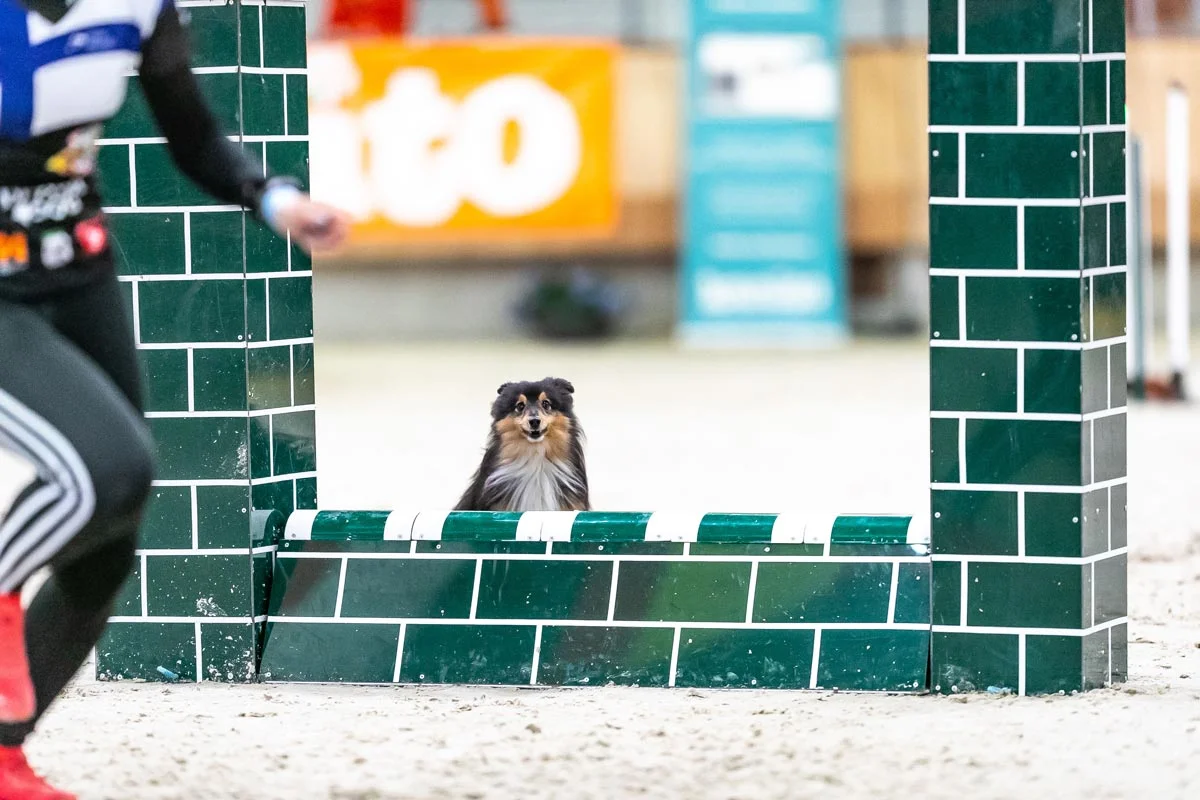Erika Hankalin (Kingi& Kamu) has treated agility dogs for over 10 years. She thinks agility dogs are well taken care of, when it comes to taking them for massages, physiotherapy or osteopathy. However, that, in her opinion is not enough: “Treatments are just 5-10% of a dog’s body care. Everything else is done e.g. at home and in the woods through nutrition and normal activities.” And by normal activities she mainly means things that don’t require any equipment at all. You can treat an agility dog’s head and body in the woods.
“Treatments are just 5-10% of a dog’s body care. Everything else is done e.g. at home and in the woods through nutrition and normal activities.”
Walking in the woods may not sound like a trendy or relevant activity for those who concentrate on competitiveness, but actually serves as an agility dog’s mental and physical training. Also, as a side effect, it does wonders for the handler. Erika thinks long walks in the woods are a much undervalued way of taking care of many things.
1. Calms the dog down and decreases tension
“Everything is part of a dog’s body care! Nutrition, everyday exercise, agility training, warm-up, cool down, taking care of a dog’s physical needs such as cutting nails (long nails affect the posture), taking care of the dog’s mental state and so on. The dog's mental state should be taken into consideration more, because if the dog is stressed and tense, so is its body. Today we don’t even talk about body and mind, instead we talk about bodymind.”
“The dog’s mental state should be taken into consideration more, because if the dog is stressed and tense, so is its body. ”
It’s easier to increase a dog’s stress level than get it down: “Many dogs are in a loop,l in which the owner thinks the dog has too much energy and tries to deal with the energy by taking the dog to different hobbies and activities every day and sometimes even leaves out normal long walks. This increases the dog's stress level and also its body starts to get all kinds of symptoms. If the dog seems hyperactive, instead of adding activities, it would be good to consider decreasing its stress level.”
“If the dog seems hyperactive, instead of adding activities, it would be good to consider decreasing its stress level.”
Erika recommends forgetting multiple hobbies and instead taking long and peaceful walks in the woods with the dog: “Long and slow-paced walks in the woods work magic for both the dog’s and the handler’s mind, and thus also for the body.” She reminds us that throwing a ball plays no part on these walks: “Fetching increases the dog’s drive and stress level, and it also burdens the dog’s body directly. Instead of fetching, let them sniff things and just be dogs.”
But what if the dog just runs insanely at the forest? Erika assures that if we don’t provoke the dog by throwing anything, in time, the dog finds also other gaits than gallop: “You can e.g. keep treats in your pocket and start examining something on the ground. When your dog starts to move close to you calmly, reward it with treats. Repeat this regularly.” Erika recommends teaching controlled pace, especially trot, already to puppies, first for just 30 seconds at a time, adding duration gradually and adding some cue, like “slowly” to it.
2. Improves the basic level of fitness
Erika has noticed that many agility dogs should have a better basic level of fitness. “All dobo training, balancing exercises and tricks that help a dog to better perceive their legs and use their body well are good. However, agility as a sport requires a good basic fitness level and that is not built with a dobo ball in the living room. Instead, that is built in the woods, on rocky land, swamps, climbing up and down the hill in a controlled fashion, walking or trotting. Too often people just let their dogs run insanely in a sand pit and think that that takes care of the dog's basic fitness. It really doesn’t. It’s better to go for a two-hour walk in the woods, or alternatively walk up and down the sand pit so that the dog walks or trots. This is also great exercise for the handler.”
3. Improves body control
“When an agility dog has spent a lot of time in versatile terrain from a small puppy, its body control is at a much better level than if it hasn’t. The dog has to reverse, control its speed, jump over branches and lift its feet over roots. At the same time, it learns to use its feet and body well.”
As an example, Erika mentions her own dog, a Bernese mountain dog Kermit. They have never done actual body control training. Instead they have spent hours and hours in the woods, 5 to 15 kilometres per day, and not on the ready made paths. “All my dogs, also Kermit, have perceived all their legs and have good body control.”
Besides, walking or jogging in the woods is like agility drills for the handler, tying us to our environment and ourselves. We are back to point one and everything is, in effect, closely connected. But now, go to the woods, smell the flowers, enjoy the journey and you may be surprised by the results!
Other articles about agility and life with agility dogs
How to take care of an agility dog’s nutrition and hydration?
Tobias Wüst - My ideas for improvement come from results
Ole Kristoffer Sagløkken: Always quality before quantity in agility training
Mark Laker: Set goals to get motivation and drive in agility training



